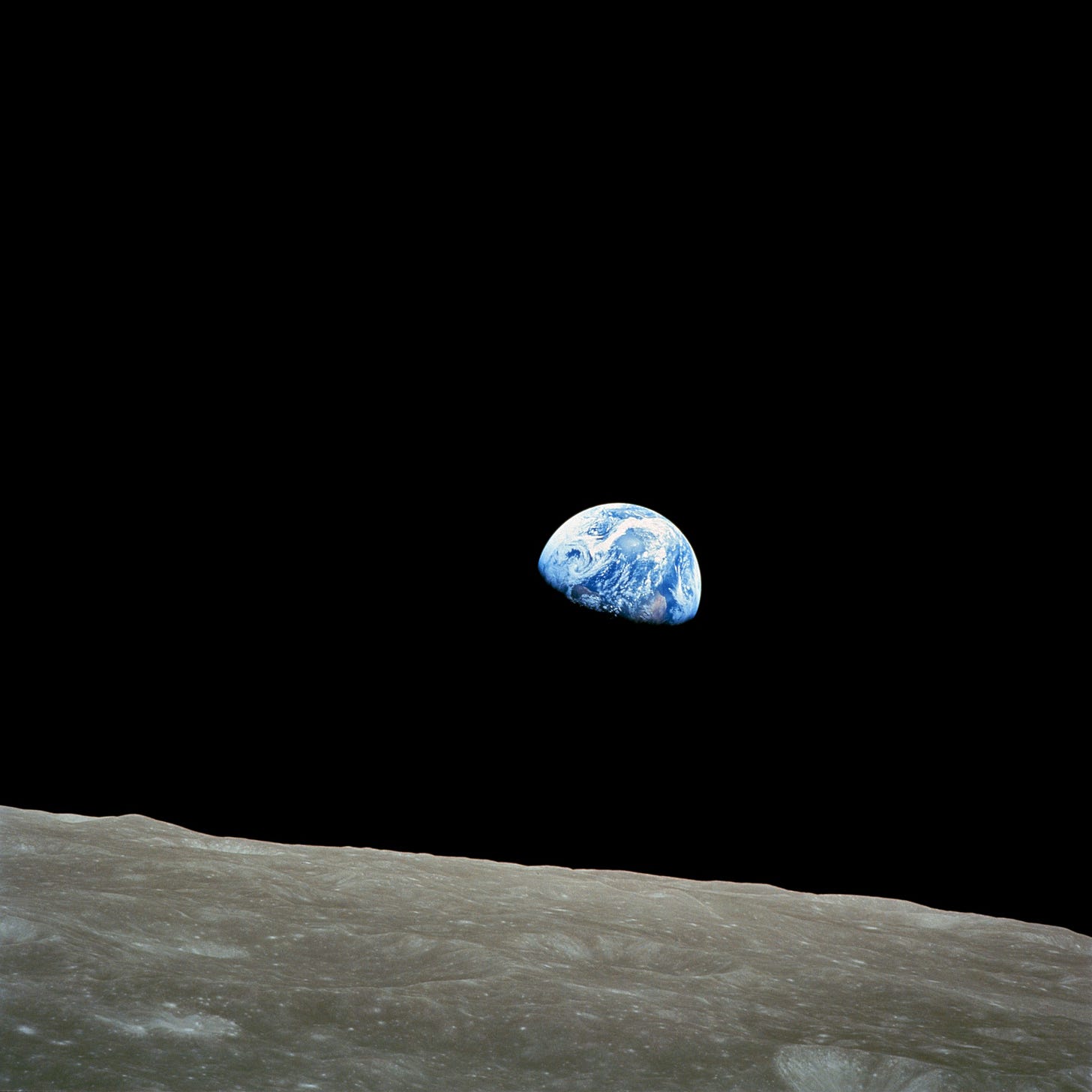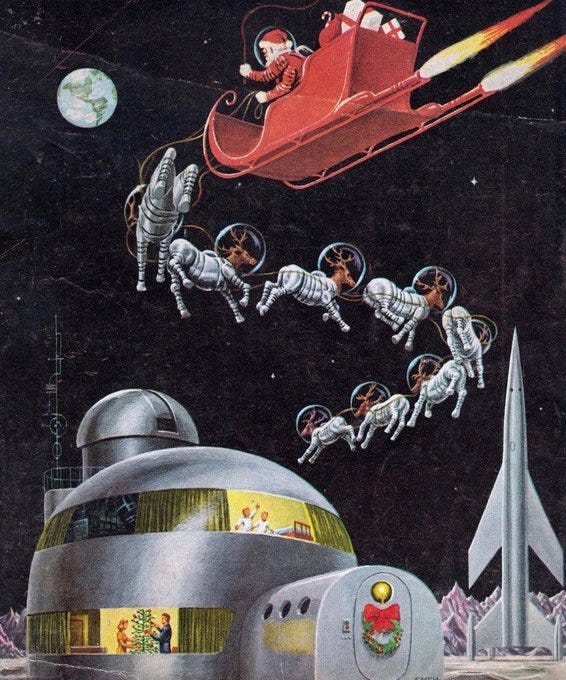🌎 The frustrating story behind 'Earthrise,' one of the most famous photos ever
Also: FDA failure; China goes modular nuclear; the metaverse; and more ...
“All this represents an inglorious letdown for an effort whose brilliant outcome was and is one of the proudest fruits of human ingenuity and courage.” - New York Times editorial (September 4, 1970), after NASA announced it was canceling two of the six remaining Apollo flights and terminating Project Apollo.
🎄 Note to my wonderful Faster, Please! subscribers: This newsletter will be modified, both in format and publishing schedule, between now and year’s end. Have a wonderful holiday season! And please tell your family, friends, and colleagues — even randos on the street — to check out Faster, Please and subscribe!
Short Read
🌎 The frustrating story behind 'Earthrise,' one of the most famous photos ever
As Apollo 8 began its fourth lunar orbit on Christmas Eve, 1968, flight engineer Bill Anders was busy photographing the lunar surface when suddenly Earth slid into view. “Oh my God!” Anders said, according to the NASA recording of the event. “There's the Earth coming up. Wow, that's pretty.” When Anders quickly started snapping away with his black-and-white camera, fellow crew member Frank Borman joked, “Hey, don't take that, it's not scheduled.” After locating some 70mm Kodak color film, Anders took a photograph of his distant home — a beautiful blue-and-white planetary oasis against the stark, empty black of space — that has since become one of the most reproduced images of all time.
The next year, the “Earthrise” image was placed on a US Postal Service stamp commemorating Apollo 8’s historic flight around the Moon. And the photograph ended up hanging on a wall in the Oval Office, prominent just to the right of President Richard Nixon’s Wilson desk. In his autobiography published just after he left the presidency because of the Watergate scandal, Nixon called space exploration “one of the last of the great challenges to the American spirit. Space is perhaps the last frontier truly commensurate with America’s capacity for wonder.”
But the Earthrise photo was removed from the Oval Office at some point in 1970, perhaps around the same time Nixon gave a speech ending NASA’s privileged budgetary status and lowering America’s human spaceflight ambitions. As John Logsdon of The Planetary Society has written, “Nixon apparently did not want to be reminded of what remarkable things human explorers could accomplish as he made the decisions that would keep humans in low Earth orbit for the next half-century.” (Although Nixon blamed a fickle public that grew bored with the Space Race, it also seems clear he was badly shaken by the near-disaster of Apollo 13.)
We are now in the sixth decade of limited ambitions in space, squandering the potential for commerce, exploration, and pure discovery. I don’t think there will be a seventh. Let’s hope not. I would urge readers to check out my space-related podcasts over the past year or so, all of which include links to full transcripts:
Eric Berger: Elon Musk and the rise of SpaceX
John Logsdon: The Apollo program and the future of space exploration
Charles Fishman: Was the Apollo program a failure?
John Roth, Rich Boling, Michael Gold, & Matthew Weinzierl: The space economy
Daniel Deudney: The case against space expansionism
Tim Fernholz, Sara Seager, Stan Veuger, & Matt Weinzierl: The future of space exploration
Ronald D. Moore: The sci-fi optimism of ‘For All Mankind,’ ‘Battlestar Galactica,’ and ‘Star Trek’
🧪 This Scientist Created a Rapid Test Just Weeks Into the Pandemic. Here’s Why You Still Can’t Get It. - ProPublica |
Bosch’s tests missed the FDA’s high bar. It wasn’t until the spring of 2021 that much larger companies were able to design similar tests — relatively inexpensive, over-the-counter rapid tests — that the agency found acceptable.“You could have antigen tests saving lives since the beginning of the pandemic,” said Bosch, sitting in her lab at MIT. “That’s the sad story.” As ProPublica recently detailed, many companies with at-home tests have been stymied by an FDA review process that has flummoxed experts and even caused one agency reviewer to quit in frustration.
♾ Year in a word: Metaverse - Richard Water, Financial Times |
One reason for the industry hype is a belief that the metaverse could be the most important computing platform since the advent of the smartphone. If Apple launches a headset of its own in 2022 or 2023, as rumoured, it could do much to propel the idea into the mainstream. It is easy to imagine some limited forms of the metaverse catching on. We already spend much of our time in digital places — an online store, a social network, an office chat group. These might be more engaging if we could enter them more fully, even through a simple 2D avatar. But the vision of a life lived fully in virtual reality is likely to remain the stuff of science fiction for a long time to come.
⚛ China is Home to World's First Small Modular Nuclear Reactor - Bloomberg | This is really a textbook case of America needing to adopt the Faster, Please! ethos. From the piece: “The plant is the world’s first pebble-bed modular high-temperature gas-cooled reactor, heating up helium instead of water to produce power. It’s a so-called fourth generation reactor, designed to shut down passively if something goes wrong — in contrast to active systems that may not be able to trigger safety measures if power fails, which is what happened at the Fukushima Daiichi accident in Japan a decade ago.” Fun Fact: China is expected to invest nearly half a trillion dollars into new nuclear plants over the next 15 years and overtake the US as the top generator of nuclear electricity.
🧠 Can genetics improve social mobility? - The Economist |
💻 A Quadrillion Mainframes on Your Lap - Rodney Brooks, IEEE Spectrum |
By 1961, a few universities around the world had bought IBM 7090 mainframes. The 7090 was the first line of all-transistor computers, and it cost US $20 million in today's money, or about 6,000 times as much as a top-of-the-line laptop today. Its early buyers typically deployed the computers as a shared resource for an entire campus. Very few users were fortunate enough to get as much as an hour of computer time per week. … So now the 7090 looks to have run at about a quadrillionth (10-15) the speed of your 2021 laptop. A week of computing time on a modern laptop would take longer than the age of the universe on the 7090.
🕸 The new paradigm of economic complexity - Pierre-Alexandre Balland, Tom Broekel, Dario Diodato, Elisa Giuliani, Ricardo Hausmann, Neave O'Clery, David Rigby | Great summary of complexity economics — where the core idea is that “developed nations are capable of supplying products or services that require a greater variety (hence a greater amount) of knowledge” — and its implications for “growth, development, technological change, income inequality, spatial disparities, and resilience.” I make take a deeper dive in 2022. But if you can’t wait, I recommend this Q&A I did in 2018 with Cesar Hidalgo, a statistical physicist and author of Why Information Grows: The Evolution of Order, from Atoms to Economies. Really great book, too.
(“Christmas on the Moon in Ed Emshwiller's cover art for Galaxy Science Fiction, December 1954.” - @HumanoidHistory)






How could Richard Nixon, by a unilateral decision in 1970, bar NASA from sending humans beyond low-earth orbit for the next 50 years?? He's a handy scapegoat, but you can't blame him for everything!